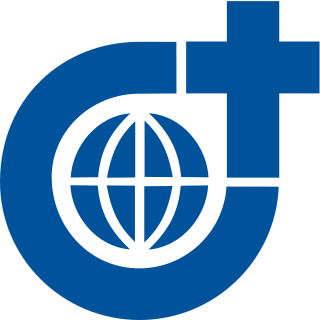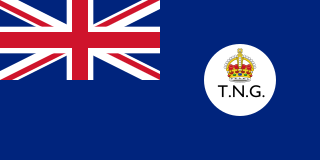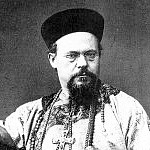Related Research Articles

Transport in Papua New Guinea is mainly based around roads and air travel. It is in many cases heavily limited by the mountainous terrain and copious amount of rainfall and frequent severe weather occurring in many locations, such as Lae. The capital, Port Moresby, is not linked by road to any of the other major towns and many highland villages can only be reached by light aircraft or on foot.

German New Guinea consisted of the northeastern part of the island of New Guinea and several nearby island groups and was the first part of the German colonial empire. The mainland part of the territory, called Kaiser-Wilhelmsland, became a German protectorate in 1884. Other island groups were added subsequently. The Bismarck Archipelago, and the North Solomon Islands were declared a German protectorate in 1885. The Caroline Islands, Palau, and the Mariana Islands were bought from Spain in 1899. German New Guinea annexed the formerly separate German Protectorate of Marshall Islands, which also included Nauru, in 1906. German Samoa, though part of the German colonial empire, was not part of German New Guinea.

Morobe Province is a province on the northern coast of Papua New Guinea. The provincial capital and largest city is Lae. The province covers 33,705 km2, with a population of 674,810, and since the division of Southern Highlands Province in May 2012 it is the most populous province. It includes the Huon Peninsula, the Markham River, and delta, and coastal territories along the Huon Gulf. The province has nine administrative districts. At least 101 languages are spoken, including Kâte and Yabem language. English and Tok Pisin are common languages in the urban areas, and in some areas pidgin forms of German are mixed with the native language.

The Evangelical Lutheran Church of Papua New Guinea is a Protestant church denomination located in Papua New Guinea that professes the Lutheran branch of the Christian faith. The Church is incorporated by a 1991 Act of the Parliament of Papua New Guinea and it has a baptized membership of approximately 900,000 members.

Education in Papua New Guinea is managed through nineteen provinces and two district organisational units. It is tuition-free and attendance is not compulsory.

Religion in Papua New Guinea is dominated by various branches of Christianity, with traditional animism and ancestor worship often occurring less openly as another layer underneath or more openly side by side with Christianity. The Catholic Church has a plurality of the population. The courts, government, and general society uphold a constitutional right to freedom of speech, thought, and beliefs. A secular state, there is no state religion in the country, although the government openly partners with several Christian groups to provide services, and churches participate in local government bodies.

The Society of the Divine Word, abbreviated SVD and popularly called the Verbites or the Divine Word Missionaries, and sometimes the Steyler Missionaries, is a Catholic clerical religious congregation of Pontifical Right for men. As of 2020, it consisted of 5,965 members composed of priests and religious brothers working in more than 70 countries, now part of VIVAT international. It is one of the largest missionary congregations in the Catholic Church. Its members add the nominal letters SVD after their names to indicate membership in the Congregation. The superior general is Paulus Budi Kleden who hails from Indonesia.

The Anglican Church of Papua New Guinea is a province of the Anglican Communion. It was created in 1977 when the Province of Papua New Guinea became independent from the Province of Queensland in the Church of England in Australia following Papua New Guinea's independence in 1975.

The Territory of New Guinea was an Australian-administered United Nations trust territory on the island of New Guinea from 1914 until 1975. In 1949, the Territory and the Territory of Papua were established in an administrative union by the name of the Territory of Papua and New Guinea. That administrative union was renamed as Papua New Guinea in 1971. Notwithstanding that it was part of an administrative union, the Territory of New Guinea at all times retained a distinct legal status and identity until the advent of the Independent State of Papua New Guinea.
The Rhenish Missionary Society was one of the largest Protestant missionary societies in Germany. Formed from smaller missions founded as far back as 1799, the Society was amalgamated on 23 September 1828, and its first missionaries were ordained and sent off to South Africa by the end of the year.

The Missionary Sisters Servants of the Holy Spirit, also known as Holy Spirit Missionary Sisters, or simply Holy Spirit Sisters is a religious congregation within the Catholic Church. The group has 3,000 members in 46 different countries. The congregation was founded by Arnold Janssen in 1889 in Steyl, the Netherlands. Janssen had previously founded in 1875 a male missionary congregation called Divine Word Missionaries. Janssen chose Maria Helena Stollenwerk, called Mother Maria (1852–1900) and Hendrina Stenmanns, called Mother Josepha (1852–1903) as co-foundresses.

The Roman Catholic Diocese of Mendi is a suffragan diocese of the Roman Catholic Archdiocese of Mount Hagen, in Mendi, Papua New Guinea. It was erected Prefecture Apostolic in 1958 and elevated Vicariate Apostolic in 1965. It was elevated, along with other Oceanic vicariates and prefectures, to a diocese on 15 November 1966. The bishop is Donald Lippert, OFMCap.

The Roman Catholic Diocese of Alotau-Sideia is a Latin suffragan diocese in the ecclesiastical province of the Metropolitan Roman Catholic Archdiocese of Port Moresby, yet remains dependent on the Roman Congregation for the Missions Propaganda Fide.
The Roman Catholic Archdiocese of Rabaul is a Latin Rite Metropolitan Archdiocese in Papua New Guinea.
Yule Island is a small island in Central Province, Papua New Guinea. It is located 160 km NW from Port Moresby, on the south coast of Papua New Guinea.
Archbishop Sir Virgil Patrick Copas, was archbishop of Kerema and Port Moresby, both in Papua New Guinea.

Johann Baptist Anzer, S.V.D., was a member of the Society of the Divine Word, popularly known as the Divine Word Missionaries, and Catholic bishop of the German Mission to China in Shandong Province.

The Sepik is the longest river on the island of New Guinea, and the second largest in Oceania by discharge volume after the Fly River. The majority of the river flows through the Papua New Guinea (PNG) provinces of Sandaun and East Sepik, with a small section flowing through the Indonesian province of Papua.

As the township of Lae, in Morobe Province, Papua New Guinea is a relatively new entity, the history of the Lae environs is much older.
References
- ↑ The World Factbook
- ↑ Lamport, Mark A. (2018). Encyclopedia of Christianity in the Global South, vol. 2. Lanham: Rowman and Littlefield. p. 617. ISBN 9781442271579.
- ↑ Huber, Mary Taylor (1987). "Constituting the Church: Catholic Missionaries on the Sepik Frontier". American Ethnologist. 14 (1): 107–125. doi:10.1525/ae.1987.14.1.02a00070. JSTOR 645636.
- ↑ Hempenstall, Peter J (1975). "The Reception of European Missions in the German Pacific Empire: The New Guinea Experience". Journal of Pacific History. 10 (1): 46–64. doi:10.1080/00223347508572265.
- ↑ Hempenstall, Peter J (1978). Pacific Islanders Under German Rule. Canberra: ANU Press. p. 137. ISBN 9781921934322.
- ↑ "Dutch missionaries among ten casualties in 1904 Papua killing spree". goDutch.com. 2010. Retrieved 7 July 2020.
- ↑ "Alexishafen Catholic Mission". Pacific Wrecks. 2019. Retrieved 12 July 2020.
- ↑ Chow, Sylvia, ed. (2007). Sacred Heart School: For the sake of the children. Kedron, Qld: Sacred Heart School Reunion Committee. ISBN 9780646476490.
- ↑ Susan Brinkmann (December 5, 2008). "The Greatest Story Never Told: Modern Christian Martyrdom". The Catholic Standard and Times. Archived from the original on 2008-12-08. Retrieved 2008-12-09.
- ↑ Hunter, Claire (14 Sep 2020). "'It was a real labour of love'". Australian War Memorial. Retrieved 17 Sep 2020.
- ↑ "Berenice Twohill, Prisoner of the Japanese". Australians at War Film Archive. Retrieved 5 July 2020.
- ↑ "Ted Harris MSC, 80th anniversary of his self-sacrifice". Missionaries of the Sacred Heart. 20 Dec 2022. Retrieved 21 Dec 2022.
- ↑ Nolan, Malachy J (2017). "Death and displacement: Catholic missionaries in New Guinea in World War 2". Australasian Catholic Record. 94 (1): 45–54.
- ↑ Sr Antoninus (1985). "Birds of paradise and drums that announce Christ's peace". Annals Australasia . Archived from the original on 7 September 2015. Retrieved 18 July 2020.
- ↑ Castro-Salle, Florence (6 September 2015). "The early Filipino missionaries & boat builder Francis Castro". PNG Attitude. Retrieved 23 July 2020.
- ↑ Awikiak, Glenda (November 29, 2018). "Catholic sisters celebrate 100 years of mission to PNG". The National. Port Moresby. Retrieved 21 July 2020.
- ↑ Page, Jean (2016). "Land of Apocalypse – James McAuley's encounter with the Spirit: the French Catholic Mission of the Sacred Heart, Kubuna, New Guinea" (PDF). Journal of the Australian Catholic Historical Society. 37 (1): 18–31. Retrieved 13 December 2023.
- ↑ Mennis, Mary R (2002). "Ross, William Anthony (1895–1973)". Australian Dictionary of Biography. Retrieved 23 July 2020.
- ↑ Laracy, Hugh (2015). "Imperium in imperio? The Catholic Church in Bougainville". In Regan, Anthony J (ed.). Bougainville Before the Conflict. ANU Press. pp. 125–135. ISBN 9781921934247. JSTOR j.ctt1bgzbgg.16.
- ↑ Dennis, Noel (1993). "Heroic Marist Brothers martyred in the Solomons". Annals Australasia . Archived from the original on 2015-09-07. Retrieved 18 July 2020.
- ↑ Momis, Elizabeth Ibua (2015). "The Church's role in development in Bougainville". Tok Pisin English Dictionary. Retrieved 18 July 2020.
- ↑ Gibson, Eve (2015). "MSC history: Fr Frank Flynn". Missionaries of the Sacred Heart Australia. Retrieved 12 May 2021.
- ↑ J. Lamb, This is mission life: memories of mission: Daughters of Our Lady of the Sacred Heart, Journal of the Australian Catholic Historical Society, 37 (1) (2016) Archived 2017-02-02 at the Wayback Machine , 106-115.
- ↑ Ewart, Richard (22 March 2016). "Church health service cuts in PNG to affect rural communities the most". ABC Radio Australia: Pacific Beat. Retrieved 6 July 2020.
- ↑ "Pope St John Paul II's 2nd Apostolic Visit to Papua New Guinea". TotusTuus. Retrieved 5 July 2020.
- ↑ "RIBAT Card. John, M.S.C." Vatican Press Office: Documentation. Retrieved 5 July 2020.
- ↑ Cavanaugh, Ray (March 4, 2017). "Papua New Guinea: Unique challenges face some of the world's most isolated Catholics". Catholic World Report. Retrieved 7 July 2020.
- ↑ Sadowski, Dennis (March 15, 2018). "Climate change is top priority for Cardinal Ribat of Papua New Guinea". America: The Jesuit Review. Retrieved 7 July 2020.